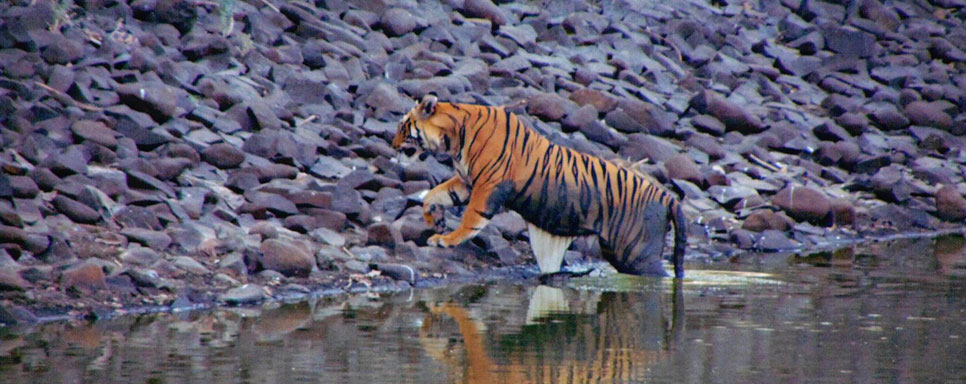How to Plan for Tipeshwar for a Quick Escape

Nestled in the serene landscapes of Maharashtra, Tipeshwar Wildlife Sanctuary is a hidden gem for nature lovers and wildlife enthusiasts. This sanctuary offers an ideal destination for a quick escape from the busy schedules of city life. Tipeshwar is a haven for those seeking tranquillity amidst nature. Its proximity to major urban centres like Nagpur and Hyderabad makes it an easily accessible getaway, perfect for weekend plans. With its picturesque landscapes, rich wildlife, and easy accessibility, Tipeshwar is a must-visit for nature enthusiasts. So, pack your bags, plan your route, and get ready to immerse yourself in the natural beauty of Tipeshwar. From its lush green surroundings to the thrill of spotting tigers in their natural habitat, Tipeshwar has something for everyone.
Getting to Tipeshwar
If you're wondering How to reach Tipeshwar, the sanctuary is well-connected by road, rail, and air, making it convenient for tourists coming from various parts of the country. The nearest city is Nagpur, located about 208 km away, while Hyderabad is approximately 349 km from Tipeshwar.
• By Road: The most popular way to reach Tipeshwar is by car. The roads to Tipeshwar are in good condition, ensuring a comfortable drive. From Nagpur, it takes about 4-5 hours, while the journey from Hyderabad takes around 7-8 hours.
• By Train: The nearest railway station is Adilabad, about 44 km away. From there, you can hire a taxi or take a bus to reach the sanctuary.
• By Air: The closest airport to Tipeshwar is located in Nagpur, offering excellent connectivity to major cities throughout India. After landing, you can hire a cab or opt for a self-drive option to reach Tipeshwar.
Best Time to Visit Tipeshwar
The ideal time to visit Tipeshwar Wildlife Sanctuary depends on what you wish to experience.
• Summer: Summers from March to June may be hot, but this is the best time for wildlife sightings, especially near water bodies. Spotting tigers, leopards, and deer becomes easier during this season.
• Winter: If you prefer a comfortable climate, winter is the perfect season, ranging from October to February. The lush greenery and cool weather make it ideal for exploring the sanctuary.
• Monsoon: It's best to avoid visiting during the monsoon from July to September, as the sanctuary might be inaccessible due to heavy rains.
The sanctuary is generally open from sunrise to sunset, but it's advisable to check the exact timings before planning your visit. The time slots of the morning and evening safaris slightly vary between the summer and the winter season.
Booking Safaris and Accommodation
To make the most of your visit, it's crucial to arrange your Tipeshwar online safari booking in advance. Online platforms and local travel agencies offer easy booking options. Jeep safaris are the best way to explore the sanctuary, providing an opportunity to witness its rich biodiversity. The booking procedure can be completed in simple steps and you can secure your safari by making your payment online. However, before continuing with the payment process, learn about the terms and conditions regarding cancellation and refund policies.
For accommodation, you can choose from several options ranging from budget-friendly guesthouses to luxurious resorts near the sanctuary. Staying close to the sanctuary allows you to enjoy early-morning safaris without the hassle of long commutes. The hotels and resorts also tend get get fully occupied during the peak season, that is the winter months from November to February.
What to Pack for a Tipeshwar Tour
Packing smartly can significantly enhance your experience at Tipeshwar. Here's what you should include:
• Clothing: Opt for lightweight, breathable clothes in earthy tones to blend with the surroundings. Don't forget sturdy shoes for walking or hiking.
• Protection from the Sun: Carry sunscreen, sunglasses, and a wide-brimmed hat to protect yourself from the sun, especially during summer safaris.
• Photography Essentials: If you're into wildlife photography, pack your DSLR, telephoto lens, and binoculars to capture those perfect shots.
• Snacks and Hydration: Bring plenty of water and light snacks to keep yourself energized during the trip. However, eating or munching inside the safari zones are usually not allowe. So, do not forget to abide by the guidelines of the sanctuary as well as the intructions of the safari guide and the driver.